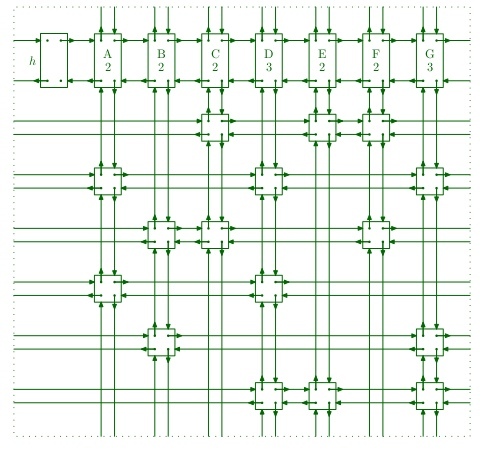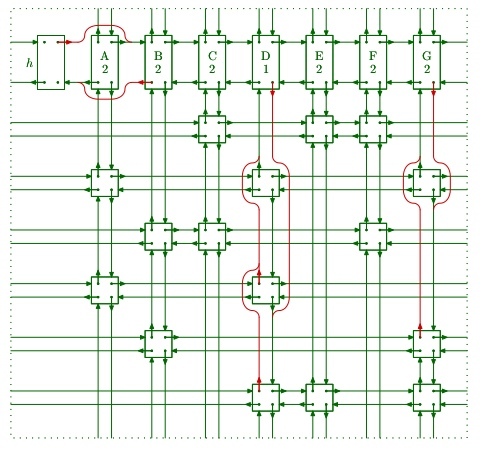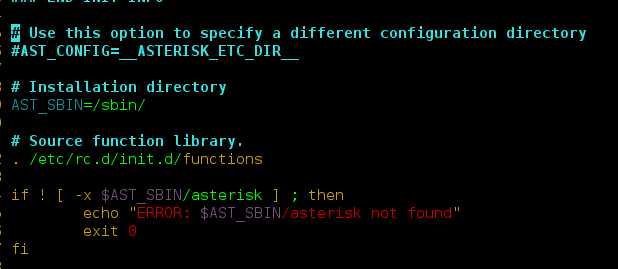In the article Exact Cover Problem and Algorithm X | Set 1 we discussed the Exact Cover problem and Algorithm X to solve the Exact cover problem. In this article, we’ll discuss the implementation details of Algorithm X using Dancing Links Technique (DLX) proposed by Dr Donald E. Knuth in his paper “Dancing Links”
Dancing Link Technique
Dancing link technique relies on the idea of doubly circular linked list. As discussed in previous article, we transform exact cover problem in form of matrix of 0 and 1. Here each “1” in the matrix is represented by a node of linked list and the whole matrix is transformed into a mesh of 4 way connected nodes. Each node contains following fields –
- Pointer to node left to it
- Pointer to node right to it
- Pointer to node above it
- Pointer to node below it
- Pointer to list header node to which it belongs
Each row of the matrix is thus a circular linked list linked to each other with left and right pointers and each column of the matrix will also be circular linked list linked to each above with up and down pointer. Each column list also includes a special node called “list header node”. This header node is just like simple node but have few extra fields –
- Column id
- Count of nodes in current column
We can have two different kinds of nodes but in our implementation, we will create only one kind of node with all fields for convenience with an additional “Row id” field which will tell which row this node belongs to. So for matrix – 

Four way linked matrix
So the pseudo code for search algorithm (Algorithm X) will be –
f( h.right == h ) {
printSolutions();
return;
}
else {
ColumnNode column = getMinColumn();
cover(column);
for( Node row = column.down ; rowNode != column ;
rowNode = rowNode.down ) {
solutions.add( rowNode );
for( Node rightNode = row.right ; rightNode != row ;
rightNode = rightNode.right )
cover( rightNode );
Search( k+1);
solutions.remove( rowNode );
column = rowNode.column;
for( Node leftNode = rowNode.left ; leftNode != row ;
leftNode = leftNode.left )
uncover( leftNode );
}
uncover( column );
}
Covering Node
As discussed in the algorithm, we have to remove columns and all the rows to which nodes of that column belongs to. This process is here referred as covering of node. To remove a column we can simply unlink header of that column from neighboring headers. This way this column cannot be accessed. This process is similar to removal of node from doubly linked list, suppose we want to remove node x then –
x.left.right = x.right x.right.left = x.left
Similarly to remove a row we have to unlink all nodes of row from nodes of row above and below it.
x.up.down = x.down x.down.up = x.up
Thus the pseudo code for cover(node) becomes –
Node column = dataNode.column;
column.right.left = column.left;
column.left.right = column.right;
for( Node row = column.down ; row != column ; row = row.down )
for( Node rightNode = row.right ; rightNode != row ;
rightNode = rightNode.right ) {
rightNode.up.down = rightNode.down;
rightNode.down.up = rightNode.up;
}
}
So for example, after covering column A, matrix will look like this –

covering
Here we first remove the column from other columns then we move down to each column node and remove row by traversing right, so row 2 and 4 is removed.
Uncovering Node
Suppose algorithm reached a dead end and no solution is possible in that case algorithm have to backtrack. Because we have removed columns and rows when we backtrack we have link again those removed rows and columns. This is what we are calling uncovering. Notice that the removed nodes still have pointers to their neighbors, so we can link them back again using these pointers. To uncover column we will perform covering operation but in reverse order –
x.left.right = x x.right.left = x
Similarly to uncover any row node x –
x.up.down = x x.down.up = x
Thus the pseudo code for uncover(node) will become –
Node column = dataNode.column;
for( Node row = column.up ; row != column ; row = row.up )
for( Node leftNode = row.left ; leftNode != row ;
leftNode = leftNode.right ) {
leftNode.up.down = leftNode;
leftNode.down.up = leftNode;
}
column.right.left = column;
column.left.right = column;
}
Following is the implementation of dancing link technique –
CPP
// C++ program for solving exact cover problem// using DLX (Dancing Links) technique#include <bits/stdc++.h>#define MAX_ROW 100#define MAX_COL 100using namespace std;struct Node{public: struct Node *left; struct Node *right; struct Node *up; struct Node *down; struct Node *column; int rowID; int colID; int nodeCount;};// Header node, contains pointer to the// list header node of first columnstruct Node *header = new Node();// Matrix to contain nodes of linked meshstruct Node Matrix[MAX_ROW][MAX_COL];// Problem Matrixbool ProbMat[MAX_ROW][MAX_COL];// vector containing solutionsvector <struct Node*> solutions;// Number of rows and columns in problem matrix int nRow = 0,nCol = 0;// Functions to get next index in any direction// for given index (circular in nature) int getRight(int i){return (i+1) % nCol; }int getLeft(int i){return (i-1 < 0) ? nCol-1 : i-1 ; }int getUp(int i){return (i-1 < 0) ? nRow : i-1 ; } int getDown(int i){return (i+1) % (nRow+1); }// Create 4 way linked matrix of nodes// called Toroidal due to resemblance to// toroidNode *createToridolMatrix(){ // One extra row for list header nodes // for each column for(int i = 0; i <= nRow; i++) { for(int j = 0; j < nCol; j++) { // If it's 1 in the problem matrix then // only create a node if(ProbMat[i][j]) { int a, b; // If it's 1, other than 1 in 0th row // then count it as node of column // and increment node count in column header if(i) Matrix[0][j].nodeCount += 1; // Add pointer to column header for this // column node Matrix[i][j].column = &Matrix[0][j]; // set row and column id of this node Matrix[i][j].rowID = i; Matrix[i][j].colID = j; // Link the node with neighbors // Left pointer a = i; b = j; do{ b = getLeft(b); } while(!ProbMat[a][b] && b != j); Matrix[i][j].left = &Matrix[i][b]; // Right pointer a = i; b = j; do { b = getRight(b); } while(!ProbMat[a][b] && b != j); Matrix[i][j].right = &Matrix[i][b]; // Up pointer a = i; b = j; do { a = getUp(a); } while(!ProbMat[a][b] && a != i); Matrix[i][j].up = &Matrix[a][j]; // Down pointer a = i; b = j; do { a = getDown(a); } while(!ProbMat[a][b] && a != i); Matrix[i][j].down = &Matrix[a][j]; } } } // link header right pointer to column // header of first column header->right = &Matrix[0][0]; // link header left pointer to column // header of last column header->left = &Matrix[0][nCol-1]; Matrix[0][0].left = header; Matrix[0][nCol-1].right = header; return header;}// Cover the given node completelyvoid cover(struct Node *targetNode){ struct Node *row, *rightNode; // get the pointer to the header of column // to which this node belong struct Node *colNode = targetNode->column; // unlink column header from it's neighbors colNode->left->right = colNode->right; colNode->right->left = colNode->left; // Move down the column and remove each row // by traversing right for(row = colNode->down; row != colNode; row = row->down) { for(rightNode = row->right; rightNode != row; rightNode = rightNode->right) { rightNode->up->down = rightNode->down; rightNode->down->up = rightNode->up; // after unlinking row node, decrement the // node count in column header Matrix[0][rightNode->colID].nodeCount -= 1; } }}// Uncover the given node completelyvoid uncover(struct Node *targetNode){ struct Node *rowNode, *leftNode; // get the pointer to the header of column // to which this node belong struct Node *colNode = targetNode->column; // Move down the column and link back // each row by traversing left for(rowNode = colNode->up; rowNode != colNode; rowNode = rowNode->up) { for(leftNode = rowNode->left; leftNode != rowNode; leftNode = leftNode->left) { leftNode->up->down = leftNode; leftNode->down->up = leftNode; // after linking row node, increment the // node count in column header Matrix[0][leftNode->colID].nodeCount += 1; } } // link the column header from it's neighbors colNode->left->right = colNode; colNode->right->left = colNode;}// Traverse column headers right and // return the column having minimum // node countNode *getMinColumn(){ struct Node *h = header; struct Node *min_col = h->right; h = h->right->right; do { if(h->nodeCount < min_col->nodeCount) { min_col = h; } h = h->right; }while(h != header); return min_col;}void printSolutions(){ cout<<"Printing Solutions: "; vector<struct Node*>::iterator i; for(i = solutions.begin(); i!=solutions.end(); i++) cout<<(*i)->rowID<<" "; cout<<"\n";}// Search for exact coversvoid search(int k){ struct Node *rowNode; struct Node *rightNode; struct Node *leftNode; struct Node *column; // if no column left, then we must // have found the solution if(header->right == header) { printSolutions(); return; } // choose column deterministically column = getMinColumn(); // cover chosen column cover(column); for(rowNode = column->down; rowNode != column; rowNode = rowNode->down ) { solutions.push_back(rowNode); for(rightNode = rowNode->right; rightNode != rowNode; rightNode = rightNode->right) cover(rightNode); // move to level k+1 (recursively) search(k+1); // if solution in not possible, backtrack (uncover) // and remove the selected row (set) from solution solutions.pop_back(); column = rowNode->column; for(leftNode = rowNode->left; leftNode != rowNode; leftNode = leftNode->left) uncover(leftNode); } uncover(column);}// Driver codeint main(){ /* Example problem X = {1,2,3,4,5,6,7} set-1 = {1,4,7} set-2 = {1,4} set-3 = {4,5,7} set-4 = {3,5,6} set-5 = {2,3,6,7} set-6 = {2,7} set-7 = {1,4} Solutions : {6 ,4, 2} and {6, 4, 7} */ nRow = 7; nCol = 7; // initialize the problem matrix // ( matrix of 0 and 1) with 0 for(int i=0; i<=nRow; i++) { for(int j=0; j<nCol; j++) { // if it's row 0, it consist of column // headers. Initialize it with 1 if(i == 0) ProbMat[i][j] = true; else ProbMat[i][j] = false; } } // Manually filling up 1's ProbMat[1][0] = true; ProbMat[1][3] = true; ProbMat[1][6] = true; ProbMat[2][0] = true; ProbMat[2][3] = true; ProbMat[3][3] = true; ProbMat[3][4] = true; ProbMat[3][6] = true; ProbMat[4][2] = true; ProbMat[4][4] = true; ProbMat[4][5] = true; ProbMat[5][1] = true; ProbMat[5][2] = true; ProbMat[5][5] = true; ProbMat[5][6] = true; ProbMat[6][1] = true; ProbMat[6][6] = true; ProbMat[7][0] = true; ProbMat[7][3] = true; // create 4-way linked matrix createToridolMatrix(); search(0); return 0;} |
Output:
Printing Solutions: 6 4 2 Printing Solutions: 6 4 7
The time complexity of the createToridolMatrix() function is O(n^2), where n is the number of rows and columns in the ProbMat array. This is because the function iterates through every element in the ProbMat array and creates a new node for each element that is equal to 1.
The space complexity of the createToridolMatrix() function is also O(n^2), since it creates a new node for each element in the ProbMat array that is equal to 1.
The time and space complexity of the remaining functions in the program depend on the specific implementation of the DLX algorithm and the specific problem being solved. However, in general, the time complexity of the DLX algorithm is exponential in the worst case, although it often performs much better in practice. The space complexity of the DLX algorithm is generally linear in the size of the input.
References
- https://www.ocf.berkeley.edu/%7Ejchu/publicportal/sudoku/sudoku.paper.html
- Dancing Links by Donald Knuth
This article is contributed by Atul Kumar. If you like neveropen and would like to contribute, you can also write an article using write.geeksforgeeks.org or mail your article to review-team@geeksforgeeks.org. See your article appearing on the neveropen main page and help other Geeks. Please write comments if you find anything incorrect, or you want to share more information about the topic discussed above.
Ready to dive in? Explore our Free Demo Content and join our DSA course, trusted by over 100,000 neveropen!




